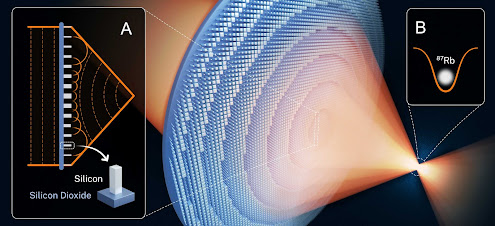Atoms are notoriously difficult to control. They zigzag like fireflies, tunnel out of the strongest containers and jitter even at temperatures near absolute zero.
Nonetheless, scientists need to trap and manipulate single atoms in order for quantum devices, such as atomic clocks or quantum computers, to operate properly. If individual atoms can be corralled and controlled in large arrays, they can serve as quantum bits, or qubits — tiny discrete units of information whose state or orientation may eventually be used to carry out calculations at speeds far greater than the fastest supercomputer.
Researchers at the National Institute of Standards and Technology (NIST), together with collaborators from JILA — a joint institute of the University of Colorado and NIST in Boulder — have for the first time demonstrated that they can trap single atoms using a novel miniaturized version of “optical tweezers” — a system that grabs atoms using a laser beam as chopsticks.
Ordinarily, optical tweezers, which garnered the 2018 Nobel Prize in Physics, feature bulky centimeter-size lenses or microscope objectives outside the vacuum holding individual atoms. NIST and JILA have previously used the technique with great success to create an atomic clock.
In the new design, instead of typical lenses, the NIST team used unconventional optics — a square glass wafer about 4 millimeters in length imprinted with millions of pillars only a few hundreds of nanometers (billionths of a meter) in height that collectively act as tiny lenses. These imprinted surfaces, dubbed metasurfaces, focus laser light to trap, manipulate and image individual atoms within a vapor. The metasurfaces can operate in the vacuum where the cloud of trapped atoms is located, unlike ordinary optical tweezers.

















.jpg)